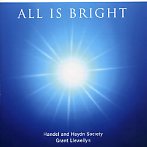The singing is accurate and assured, which is no surprise given the Handel & Haydn Society’s–and its music director’s–credentials. What is surprising is the rather dry, sterile sound and the chorus’ dispassionate manner with many of these first-rate Christmas pieces, most from the 20th-century repertoire. The opening Hodie Christus natus est by Sweelinck–a staple of Christmas choral programs everywhere–sounds disappointingly anemic. Again, everything’s in place, notewise, but the tenors sound a bit strained, the sound dull, and the “ha-ha-ha” runs are just not cool. I have to say that my overall impression is that this sounds like a gig, performed by able professionals for a commercial project. And that’s fine, except that if you’re a Christmas choral music lover, you’ve heard recordings by the Cambridge Singers, The Sixteen, various English cathedral and college choirs (including King’s, Trinity, and Westminster), and numerous American ensembles (St. Olaf’s and the Dale Warland Singers come to mind), which means that you know what real commitment to and passion for this music sounds like. And since most of the works on this CD have been recorded numerous times, you have a choice.
True, there are some unique or very rare items here–Virgil Thomson’s O My Deir Hert, Ned Rorem’s While all things were in quiet silence, Steve Pilkington’s exquisite setting of The Coventry Carol, and Eric Whitacre’s little masterpiece Lux Aurumque–that qualify this disc for a place on your Christmas CD shelf, but Pinkham’s Sweet Music isn’t one of his best (the dissonances seem more gratuituos than functional), and the Buxtehude setting of In dulci jubilo is just boring, its hard triple meter, elementary harmonies, and unimaginatively repetitive treatment of the well-known melody wearing out long before the five-plus minutes are up. On the other hand, Jennifer Higdon’s lovely, appropriately atmospheric O magnum mysterium (accompanied by flutes, glasses, and chimes) contains some wonderful ideas, but they are all used up by the climax just past the halfway point–and here is also where the engineering shows trouble with balances.
But this is followed by a beautifully sung (and balanced) rendition of Ives’ increasingly popular A Christmas Carol, a gently rocking lullaby with a few Ivesian rhythmic twists. We hear similarly fine versions of the 15th-century setting of There is no rose, Praetorius’ Lo, how a Rose e’er blooming, and several Walton pieces. Tom Vignieri’s Hodie Christus natus est, commissioned by conductor Llewellyn for the Handel & Haydn Society Chorus receives its premiere recorded performance here. It’s a decent enough work, its bold (if unoriginal) style and lively organ accompaniment effectively projecting a festive spirit, but it’s marred by baritone soloist Christòpheren Nomura’s heavy vibrato and weirdly balanced presence in the mix. It’s also too bad that Nomura adopts such an odd manner of articulation for his other solos–Cornelius’ The Three Kings and Howells’ A Spotless Rose–which amounts to a kind of delayed “leaning-in” approach to each of the notes on strong syllables. It’s irritating and distracting, calling the wrong kind of attention to the soloist.
As I said at the beginning, for many of these selections you have several other, better choices with more committed performances and warmer sound. However, if you focus on this program’s rarer repertoire–the Rorem, Higdon, Whitacre, Thomson, and Pilkington–you’ll find much to enjoy in repeated listening. In sum, an intriguingly mixed bag.
































